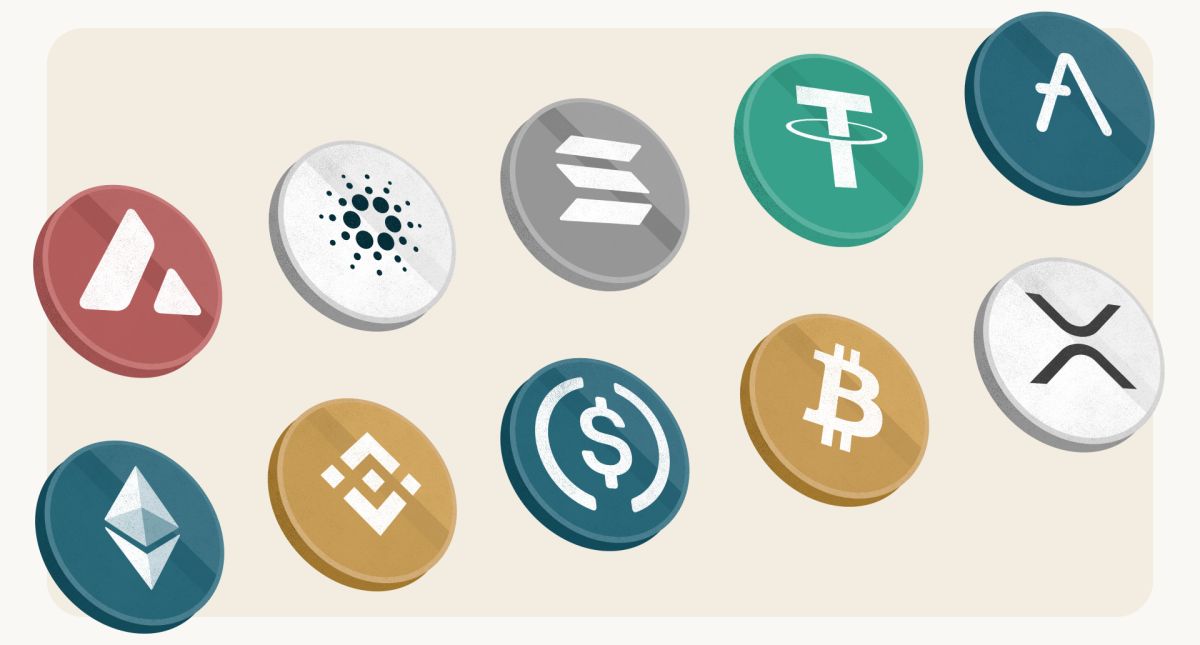Introduction
Welcome to the world of cryptocurrency! Over the past decade, cryptocurrencies have taken the financial world by storm. These digital currencies have become more than just a means of digital payment – they’ve transformed into a whole new asset class. If you’ve ever wondered how to make your own cryptocurrency, you’ve come to the right place.
Cryptocurrencies are decentralized digital currencies that use cryptography to secure transactions and control the creation of new units. Unlike traditional fiat currencies, such as the US dollar or the Euro, cryptocurrencies operate on a technology called blockchain. This distributed ledger technology ensures transparency, security, and immutability.
Creating your own cryptocurrency may seem like an overwhelming task, but with the right knowledge and resources, it’s entirely possible to bring your vision to life. In this guide, we’ll walk you through the key steps involved in creating your own digital currency.
Before we dive into the technical aspects, it’s important to understand the basic concepts of cryptocurrencies. By grasping the fundamentals, you’ll have a solid foundation for developing and launching your own cryptocurrency.
Choosing a consensus mechanism, creating a blockchain, and designing a cryptocurrency token are some of the key considerations you’ll need to address. Additionally, determining the token supply, implementing smart contracts, and planning the distribution and initial coin offering (ICO) are crucial steps towards making your cryptocurrency a reality.
Once your cryptocurrency is developed, it’s essential to focus on securing it. As cryptocurrencies are decentralized and digital in nature, they are susceptible to various security threats. Implementing robust security measures will protect your cryptocurrency and the investments made by your users.
Finally, the launch of your cryptocurrency will mark the realization of your vision. By promoting your cryptocurrency and attracting users, you can create a thriving digital ecosystem.
So, if you’re ready to embark on the exciting journey of creating your own cryptocurrency, let’s begin by understanding the core concepts of this revolutionary technology.
Understanding Cryptocurrency
Before delving into the process of creating your own cryptocurrency, it’s crucial to have a solid understanding of what cryptocurrency actually is. At its core, cryptocurrency is a type of digital or virtual currency that uses cryptography for security.
Unlike traditional currencies issued by central banks, cryptocurrencies are decentralized and operate on a technology called blockchain. This technology ensures transparency, immutability, and security in the transactions made with cryptocurrency.
One of the defining features of cryptocurrencies is their decentralization. They are not controlled by any central authority or government, making them immune to government interference or manipulation. Instead, cryptocurrencies rely on a network of computers called nodes that work together to validate and record transactions on the blockchain.
Cryptocurrencies are created through a process called mining or minting, depending on the consensus mechanism used. Mining involves solving complex mathematical problems to verify and add new transaction records to the blockchain. As a reward for their computational efforts, miners receive newly minted cryptocurrency tokens.
Another important aspect of cryptocurrencies is their limited supply. Most cryptocurrencies have a predetermined maximum supply, which means that there will only ever be a certain number of tokens in existence. This scarcity gives cryptocurrencies their intrinsic value and can contribute to their potential as an investment.
In addition to being a form of digital currency, cryptocurrencies also serve various purposes and functionalities. Some cryptocurrencies, like Bitcoin, are primarily used as a medium of exchange, similar to traditional currencies. Others, like Ethereum, have broader functionalities and can support the execution of smart contracts, enable decentralized applications, and even create other cryptocurrencies.
It’s important to note that cryptocurrencies can be highly volatile and subject to market fluctuations. The value of a cryptocurrency can experience rapid increases or declines, making it important for investors and users to closely monitor the market and exercise caution.
By understanding these fundamental aspects of cryptocurrency, you’ll be better equipped to navigate the process of creating your own digital currency. With this knowledge as a foundation, let’s move on to the key steps involved in bringing your cryptocurrency to life.
Choose a Consensus Mechanism
When creating your own cryptocurrency, one of the crucial decisions you’ll need to make is choosing a consensus mechanism. In simple terms, a consensus mechanism is a set of rules that ensures agreement and validity in the blockchain network. It determines how transactions are validated, added to the blockchain, and how consensus is achieved among the network participants.
There are several consensus mechanisms to choose from, each with its own advantages and considerations. Let’s take a look at some of the most common ones:
- Proof of Work (PoW): This consensus mechanism, used by Bitcoin and many other cryptocurrencies, requires miners to solve complex mathematical puzzles to validate transactions and add blocks to the blockchain. PoW is known for its security and resistance to attacks, but it also consumes significant computational power and energy.
- Proof of Stake (PoS): In a PoS consensus mechanism, validators are chosen based on the number of coins they hold or stake. Validators are then responsible for creating new blocks and validating transactions. PoS is considered more energy-efficient than PoW but may open up the possibility of a “rich-get-richer” scenario.
- Delegated Proof of Stake (DPoS): DPoS is a variation of PoS that involves a fixed number of elected delegates who are responsible for block creation and transaction validation. This consensus mechanism offers faster block confirmation times and is considered more scalable.
- Proof of Authority (PoA): PoA consensus relies on a select group of trusted validators who take turns in creating blocks and validating transactions. It provides fast transaction confirmation times and is suitable for private or consortium blockchains.
- Proof of Burn (PoB): PoB requires users to send their coins to an unspendable address, effectively burning them. This mechanism rewards users with a proportional amount of newly created coins, encouraging participation and reducing the total coin supply.
- Proof of Capacity (PoC): PoC utilizes users’ available storage space to validate transactions and create new blocks. This consensus mechanism is less resource-intensive and energy-consuming compared to PoW, making it more eco-friendly.
When selecting a consensus mechanism, consider factors such as security, scalability, energy efficiency, decentralization, and the specific requirements of your cryptocurrency. Each mechanism has its strengths and weaknesses, so choose the one that aligns best with your project’s goals and values.
Once you’ve chosen a consensus mechanism, you’ll be ready to move on to the next crucial step – creating a blockchain for your cryptocurrency.
Create a Blockchain
Once you have chosen a consensus mechanism, the next step in creating your own cryptocurrency is to build a blockchain. A blockchain is a decentralized ledger that records and stores all transactions made with your cryptocurrency. It serves as the backbone of your digital currency, ensuring transparency, immutability, and security.
To create a blockchain, you have two options: developing your own from scratch or utilizing an existing blockchain platform.
If you decide to build your blockchain from scratch, you’ll need to consider several key components:
- Decentralized Network: Just like other cryptocurrencies, your blockchain should be decentralized, meaning it operates on a network of nodes distributed across different locations. Each node stores a copy of the blockchain and validates transactions.
- Consensus Mechanism: Incorporate the consensus mechanism you have chosen into the blockchain to ensure that transactions are properly validated and added to the ledger.
- Data Structure: The data structure of your blockchain should be designed in a way that ensures efficient storage and retrieval of transaction records. The most common data structure is a linked list of blocks.
- Blocks and Transactions: Define the structure of each block in the blockchain, including the block header, transactions, timestamps, and other relevant data. Determine the format and fields required for transactions made within your cryptocurrency.
- Blockchain Protocol: Define the rules and protocols that govern the behavior of participants in the network. This includes rules for transaction validation, block creation, block confirmation, and network communication.
- Security Measures: Implement cryptographic algorithms, such as hashing and digital signatures, to ensure the integrity and security of your blockchain. This will protect it against potential attacks and tampering.
If building a blockchain from scratch seems complex or time-consuming, you can consider utilizing existing blockchain platforms such as Ethereum, EOS, or Hyperledger. These platforms provide a ready-made infrastructure for creating custom cryptocurrencies and decentralized applications.
When choosing a blockchain platform, consider factors such as scalability, community support, development tools, flexibility, and compatibility with your project’s requirements.
Once you have created or chosen a blockchain, the foundation for your cryptocurrency is in place. You can now move forward with designing the cryptocurrency token itself, which will represent the value and functionality within your digital ecosystem.
Designing a Cryptocurrency Token
Designing a cryptocurrency token is a crucial step in creating your own digital currency. The token represents value within your cryptocurrency ecosystem and can have various functionalities depending on your project’s objectives. Here are some key considerations when designing your token:
Token Type: Determine the type of token you want to create. The most common types are utility tokens, security tokens, and asset-backed tokens. Utility tokens provide access to services or products within your platform, while security tokens represent ownership in an asset or company. Asset-backed tokens are tied to physical assets like gold or real estate.
Token Name and Symbol: Choose a unique and memorable name for your token. Consider its brandability and relevance to your project. Additionally, select a symbol or ticker that will represent your token in trading and market platforms.
Token Standard: Decide on the technical standard that your token will follow. The most popular token standard is ERC-20, used on the Ethereum blockchain, which provides a set of rules for creating fungible tokens. Other standards like ERC-721 and ERC-1155 are used for non-fungible tokens (NFTs).
Token Supply: Determine the total supply of your token. You can choose a fixed supply or create a token with a dynamic supply model, such as inflationary or deflationary mechanisms. Consider factors like scarcity, demand, and the intended purpose of your token.
Token Decimals: Specify the number of decimal places your token will have. It determines the precision of your token’s value. For example, if your token has two decimal places, it allows for values like 1.50 or 0.25.
Token Functionality: Define the specific functionalities of your token. It can be used for transactions, staking, voting, governance, or access to specific features within your platform. Ensure that the functionalities align with your project’s goals and provide value to token holders.
Token Wallet Compatibility: Consider the compatibility of your token with different wallet providers. ERC-20 tokens, for example, are widely supported by various cryptocurrency wallets. Wallet compatibility is essential for users to store, send, and receive your token securely.
Token Migration: If you’re creating a new token on an existing blockchain platform, think about how you plan to migrate or distribute the tokens to your community. This could involve an airdrop, token sale, or a community allocation mechanism.
By carefully designing your cryptocurrency token, you can create a digital asset that aligns with your project’s objectives and provides value to your users and investors. Once the token design is finalized, you can move forward to the next steps, such as determining the token supply and planning the token distribution through an Initial Coin Offering (ICO) or another method.
Setting the Token Supply
Setting the token supply is a crucial step in creating your cryptocurrency. The token supply refers to the total number of tokens that will ever be in circulation within your ecosystem. It plays a significant role in determining the value, scarcity, and distribution of your tokens. When setting the token supply, consider the following factors:
Scarcity: The token supply directly influences the scarcity of your cryptocurrency. A limited supply can create a sense of scarcity, potentially driving up demand and value. On the other hand, an excessively high supply can dilute the value of your tokens. Balancing supply and demand is crucial to ensure a healthy token economy.
Token Utility: Consider the utility and purpose of your token within the ecosystem. If your token serves multiple purposes or has significant utility, you may need a larger token supply to accommodate the transactional needs and user base. Conversely, if the token has a specific and focused utility, a smaller token supply may be sufficient.
Fractionalization: Determine whether your token can be divided into fractional units, and if so, the decimal places to which it can be divided. This allows for flexibility in transactions and value representation. Most tokens are divisible up to 18 decimal places, but you can choose the level of granularity that best fits your project’s requirements.
Inflationary or Deflationary Model: Consider whether your token will have an inflationary or deflationary model. Inflationary models increase the token supply over time to encourage spending and circulation. Deflationary models, on the other hand, decrease the token supply through mechanisms such as token burning, promoting scarcity and potentially driving up value.
Burn Mechanisms: If you decide to incorporate token burning into your project, determine the mechanisms by which tokens will be burned. Token burning removes tokens from circulation permanently, reducing the overall token supply. It can be done through transactions, fees, or other specific actions defined within your project.
Economic Model: Develop an economic model that accounts for factors such as inflation rate, token generation rate, token distribution mechanisms, and any scheduled token releases. A well-designed economic model ensures sustainable token growth, supply management, and user engagement.
Future Growth and Expansion: Consider the potential future growth and expansion of your project when setting the token supply. If you anticipate an increase in user adoption, new features, or expansion into different markets, you may need to plan for additional tokens to accommodate future needs.
It’s important to strike the right balance when setting the token supply. Consider the utility, user base, and goals of your project while also considering the potential impact on token value and scarcity. By carefully considering these factors, you can establish an appropriate and sustainable token supply for your cryptocurrency.
Token Distribution and Initial Coin Offering (ICO)
Token distribution and the Initial Coin Offering (ICO) are crucial elements in the process of launching your cryptocurrency. Token distribution involves how your newly created tokens will be allocated and distributed to the community, while an ICO is a fundraising method where you offer your tokens in exchange for other cryptocurrencies or fiat currencies. Let’s explore these concepts in more detail:
Token Distribution: Determine how you will distribute your tokens to the community. Some common methods include:
- Airdrops: Distribute a certain number of tokens to users for free as a way to promote your project and gain traction.
- Token Sale: Offer tokens to the public through a token sale process, where users can purchase the tokens with other cryptocurrencies or fiat currencies.
- Bounty Programs: Allocate tokens to individuals or groups who contribute to your project through activities like marketing, bug reporting, content creation, or software development.
- Private Sales: Offer tokens to private investors or strategic partners as a means of securing initial funding and support for your project.
- Community Allocations: Set aside a portion of the token supply to reward early supporters, advisors, team members, or partners who contribute to the development and promotion of your project.
Consider your project’s goals, target audience, and the level of funding you require when deciding on the distribution methods. It’s important to strike a balance between community engagement, funding needs, and long-term sustainability.
Initial Coin Offering (ICO): An ICO is a fundraising event where you offer your tokens in exchange for other cryptocurrencies or fiat currencies. It’s crucial to carefully plan and execute an ICO to attract investors and boost the visibility of your project. Here are some key steps to consider:
- Project Documentation: Prepare a whitepaper that outlines your project’s vision, goals, technical details, team members, and token economics. This document helps investors understand your project’s value proposition and potential.
- Token Sale Structure: Define the terms of your token sale, including the duration, token price, minimum and maximum investment limits, bonuses or discounts, and any lock-up periods for tokens purchased during the sale.
- Marketing and Promotion: Develop a comprehensive marketing strategy to create awareness and generate interest in your ICO. Leverage social media, industry influencers, and targeted advertising to reach your target audience.
- Smart Contract Development: Create a smart contract that governs the token sale process, ensuring transparency, security, and the accurate distribution of tokens to investors.
- Token Listing: Plan for listing your token on cryptocurrency exchanges to provide liquidity and allow investors to trade your token after the ICO. Research and approach reputable exchanges that align with your project’s values.
Ensure compliance with applicable regulatory guidelines and consult legal professionals to navigate any legal considerations associated with conducting an ICO.
By carefully planning the token distribution and conducting a well-executed ICO, you can attract investors, build a strong community, and secure the necessary funding to support the development and growth of your cryptocurrency.
Mining or Staking Mechanism
Once you have created your cryptocurrency, you’ll need to determine the mechanism by which new tokens are created, validated, and added to the blockchain. Two popular methods for achieving this are mining and staking. Let’s explore these mechanisms in more detail:
Mining: Mining is a process through which new tokens are created and added to the blockchain. It involves miners using computational power to solve complex mathematical puzzles, which verifies transactions and adds them to blocks. Miners compete against each other, and the first one to solve the puzzle is rewarded with a certain number of newly minted tokens.
Mining is commonly associated with Proof of Work (PoW) consensus mechanisms, as used by Bitcoin and other cryptocurrencies. This process requires substantial computational power and energy consumption. Miners invest in specialized hardware and compete for rewards, making the blockchain secure by requiring a majority of honest miners to maintain the network’s integrity.
Staking: Staking is an alternative mechanism used in Proof of Stake (PoS) or Delegated Proof of Stake (DPoS) consensus mechanisms. In staking, users lock up a certain amount of tokens as collateral in a wallet to participate in the validation and consensus process. Instead of using computational power, validators are chosen based on the number of tokens they hold and stake.
Validators in a PoS or DPoS system have the responsibility to create new blocks and validate transactions. In return, they are rewarded with additional tokens or transaction fees, proportional to their stake. Staking provides a more energy-efficient alternative to mining and requires fewer computational resources.
The choice between mining and staking depends on several factors, including the objectives of your cryptocurrency, energy efficiency considerations, and the level of decentralization you want to achieve. Consider the following when deciding:
- Energy Efficiency: Staking is generally considered more energy-efficient compared to mining, as it relies on the amount of stake rather than computational power.
- Security: Both mechanisms can provide adequate security for your blockchain. Mining relies on the computational power of miners, while staking relies on the economic incentive provided through token ownership.
- Decentralization: Mining tends to be more decentralized, as anyone with sufficient hardware can participate. Staking may centralize power among those with larger token holdings, especially in DPoS systems where a fixed number of validators are elected.
- Economic Considerations: Mining requires investments in mining hardware and energy costs, while staking requires users to hold and lock up a certain amount of tokens.
Ultimately, the choice between mining and staking depends on your project’s goals, technological constraints, and the level of accessibility you want to provide to participants. Consider the specific requirements and characteristics of your cryptocurrency to determine which mechanism suits your needs.
Implementing Smart Contracts
Smart contracts are a fundamental component of many cryptocurrencies and blockchain-based platforms. They are self-executing contracts that automatically facilitate, verify, and enforce the terms of an agreement between parties. By incorporating smart contracts into your cryptocurrency, you can automate various processes and enable programmable functionalities. Here’s an overview of implementing smart contracts:
Understanding Smart Contracts: Smart contracts are essentially code stored on the blockchain that define the rules and conditions of an agreement. They execute automatically when triggered by specific events or conditions, eliminating the need for intermediaries and ensuring trust and transparency.
Selecting the Smart Contract Platform: Choose a smart contract platform that best aligns with your project’s requirements. Ethereum is one of the most popular platforms for smart contracts, offering robust functionality and a large developer community. Other platforms like EOS, Tron, and Cardano also provide smart contract capabilities.
Defining the Smart Contract Logic: Determine the specific logic and functionalities that your smart contract will support. This includes defining the contract’s variables, functions, and event triggers. Consider the different scenarios and conditions under which the contract should execute.
Coding the Smart Contract: Write the code for your smart contract using a programming language supported by the chosen platform. Solidity is the most commonly used language for Ethereum, while other platforms may support languages like C++, JavaScript, or Rust. Ensure that your code is secure, efficient, and follows best practices to prevent vulnerabilities and bugs.
Testing and Auditing: Thoroughly test your smart contract to identify any bugs or vulnerabilities. Conduct both unit testing and integration testing to ensure the contract functions as intended. Performing an external audit by a professional auditing firm can help identify security weaknesses and ensure code quality.
Deploying the Smart Contract: Deploy your smart contract to the chosen blockchain network. This involves submitting the contract code, along with any required dependencies and parameters, to the blockchain network. Ensure that you have sufficient funds to cover the deployment costs or gas fees required by the network.
Interacting with the Smart Contract: Users can interact with your smart contract by sending transactions that call specific functions defined within the contract. These functions can modify the contract’s state, trigger events, or return data based on the execution logic defined in the contract code.
Upgrading and Maintaining: As your project evolves, you may need to upgrade or modify your smart contract’s functionality. Ensure proper version control and consider contract upgradability mechanisms to allow for seamless updates without compromising security or disrupting user experience.
Implementing smart contracts enhances the functionality, automation, and security of your cryptocurrency. It enables the execution of trustless transactions, eliminates intermediaries, and facilitates complex agreements. By carefully developing, testing, and deploying smart contracts, you can create a robust and efficient digital ecosystem for your cryptocurrency.
Securing Your Cryptocurrency
Security is of utmost importance when it comes to cryptocurrencies. As a cryptocurrency creator, it is your responsibility to implement robust security measures to protect your users’ funds and maintain the integrity of your blockchain. Here are some key considerations for securing your cryptocurrency:
Encryption: Implement strong encryption techniques to protect sensitive data such as private keys, passwords, and user information. Utilize industry-standard cryptographic algorithms and follow best practices to ensure data confidentiality and integrity.
Secure Wallets: Encourage your users to store their cryptocurrency in secure wallets that provide strong security features. There are different types of wallets, including hardware wallets, software wallets, and paper wallets. Educate your users about the importance of selecting a reputable wallet and adhering to proper security practices.
Multi-factor Authentication: Implement multi-factor authentication (MFA) to add an extra layer of security to user accounts. Require users to provide an additional form of verification, such as a one-time password or biometric authentication, in addition to their username and password.
Regular Audits: Perform regular security audits of your cryptocurrency ecosystem, including the smart contracts, blockchain network, and any associated applications. Engage external security firms to conduct comprehensive audits and vulnerability assessments to identify and mitigate potential security risks.
Secure Network Infrastructure: Implement robust network security measures to protect against unauthorized access and attacks. Utilize firewalls, intrusion detection systems, and secure network configurations to safeguard your infrastructure. Regularly update and patch software and systems to address any known vulnerabilities.
Penetration Testing: Conduct regular penetration testing to identify vulnerabilities in your systems and applications. Ethical hackers can simulate real-world attacks to uncover security weaknesses and provide recommendations for mitigation.
Security Education: Educate your users about best security practices, such as using strong passwords, avoiding phishing attacks, and being cautious when sharing sensitive information. Provide clear guidelines on how to securely store and manage their cryptocurrency assets.
Continual Monitoring: Implement real-time monitoring and logging mechanisms to track and detect any suspicious activities or unauthorized access attempts. Monitor your network, smart contracts, and user accounts for any signs of compromise or unusual behavior.
Disaster Recovery and Backup: Develop a comprehensive disaster recovery plan and regularly backup critical data, including wallet data, smart contracts, and user information. Implement mechanisms for data recovery in the event of a security breach or system failure.
Compliance: Stay up-to-date with regulatory requirements and ensure compliance with relevant laws and regulations. This includes data protection, anti-money laundering (AML), and know-your-customer (KYC) regulations, depending on the nature of your cryptocurrency and its target audience.
By prioritizing security and implementing robust measures, you can build trust among your users and protect their assets. Continuously stay informed about emerging security threats and technologies to adapt and evolve your security practices accordingly.
Launching Your Cryptocurrency
After going through the necessary steps of creating and securing your cryptocurrency, the time comes to launch it and introduce it to the world. The launch of your cryptocurrency marks a significant milestone in your project’s journey. Here are some steps to consider when launching your cryptocurrency:
Marketing and Promotion: Develop a comprehensive marketing strategy to generate awareness and excitement about your cryptocurrency. Utilize social media, industry influencers, targeted advertising, and content marketing to reach your target audience. Highlight the unique features and benefits of your cryptocurrency to attract users and investors.
Community Engagement: Foster an active and engaged community around your cryptocurrency. Create channels for communication and support, such as forums, social media groups, and chat platforms. Regularly engage with your community, address their concerns, and provide updates to build trust and loyalty.
Partnerships and Integrations: Seek strategic partnerships and collaborations to enhance the adoption and utility of your cryptocurrency. Explore integration possibilities with existing platforms, wallets, and exchanges to provide seamless access and liquidity for your users.
Exchange Listings: Secure listings on reputable cryptocurrency exchanges to provide liquidity and accessibility for your users. Research and approach exchanges that align with your project’s values, and comply with their listing requirements and procedures.
User Onboarding: Develop a user-friendly onboarding process that allows users to easily acquire and utilize your cryptocurrency. Provide clear instructions, tutorials, and documentation to guide users through the process of setting up wallets, making transactions, and engaging with your ecosystem.
Continuous Development: Engage a dedicated development team to continue enhancing and improving your cryptocurrency. Regularly release updates, address bugs and security vulnerabilities, and introduce new features based on user feedback and market demands.
Regulatory Compliance: Stay up-to-date with legal and regulatory requirements related to cryptocurrencies in your jurisdiction. Ensure compliance with relevant laws and regulations, including data protection, financial regulations, and tax obligations. Consult legal professionals to navigate any legal considerations specific to your cryptocurrency.
User Education: Educate your users on how to securely manage and store their cryptocurrency assets. Provide educational resources, guidelines, and best practices to help users protect their funds and avoid scams or phishing attempts. Promote responsible and informed use of your cryptocurrency.
Continued Support and Maintenance: Provide ongoing support to your users, addressing their inquiries and concerns promptly. Maintain a reliable infrastructure, including nodes, network stability, and customer support channels, to ensure a smooth user experience.
Launching your cryptocurrency requires careful planning, effective marketing, user engagement, and ongoing development. By focusing on building a strong brand, fostering a supportive community, and continuously improving your product, you can establish a successful and sustainable cryptocurrency that makes a significant impact in the market.
Conclusion
Congratulations on completing the journey of creating your own cryptocurrency! Throughout this guide, we’ve discussed the key steps involved in bringing your vision to life. From understanding the fundamentals of cryptocurrency to designing the token, setting the supply, and implementing security measures, we’ve covered the essential aspects of creating and launching a successful digital currency.
By choosing the right consensus mechanism, creating a robust blockchain, designing a unique and functional token, and ensuring the security of your cryptocurrency, you’ve laid a strong foundation for your project’s success. Additionally, the token distribution and Initial Coin Offering (ICO) process have allowed you to engage with the community and secure the necessary resources to move forward.
Launching your cryptocurrency requires effective marketing, community engagement, and continuous development. By keeping your users at the forefront, listening to their feedback, and adapting to market demands, you can create an ecosystem that captures the interest and loyalty of your target audience.
Remember that the world of cryptocurrencies is ever-evolving, with new technologies, regulations, and market trends emerging constantly. Stay informed, be adaptable, and continue learning as you navigate the exciting and dynamic landscape of cryptocurrencies.
As you embark on this journey, always prioritize security, transparency, and user experience. By ensuring the integrity of your blockchain, educating your users, and providing reliable support, you can build trust and credibility in the cryptocurrency community.
With dedication, innovation, and a strong vision, your cryptocurrency has the potential to make a significant impact in the digital currency space. Stay determined, persevere through challenges, and never cease to evolve and improve your creation.
Good luck as you launch your cryptocurrency into the world, and may it thrive and contribute to the advancement of the decentralized digital economy!

























